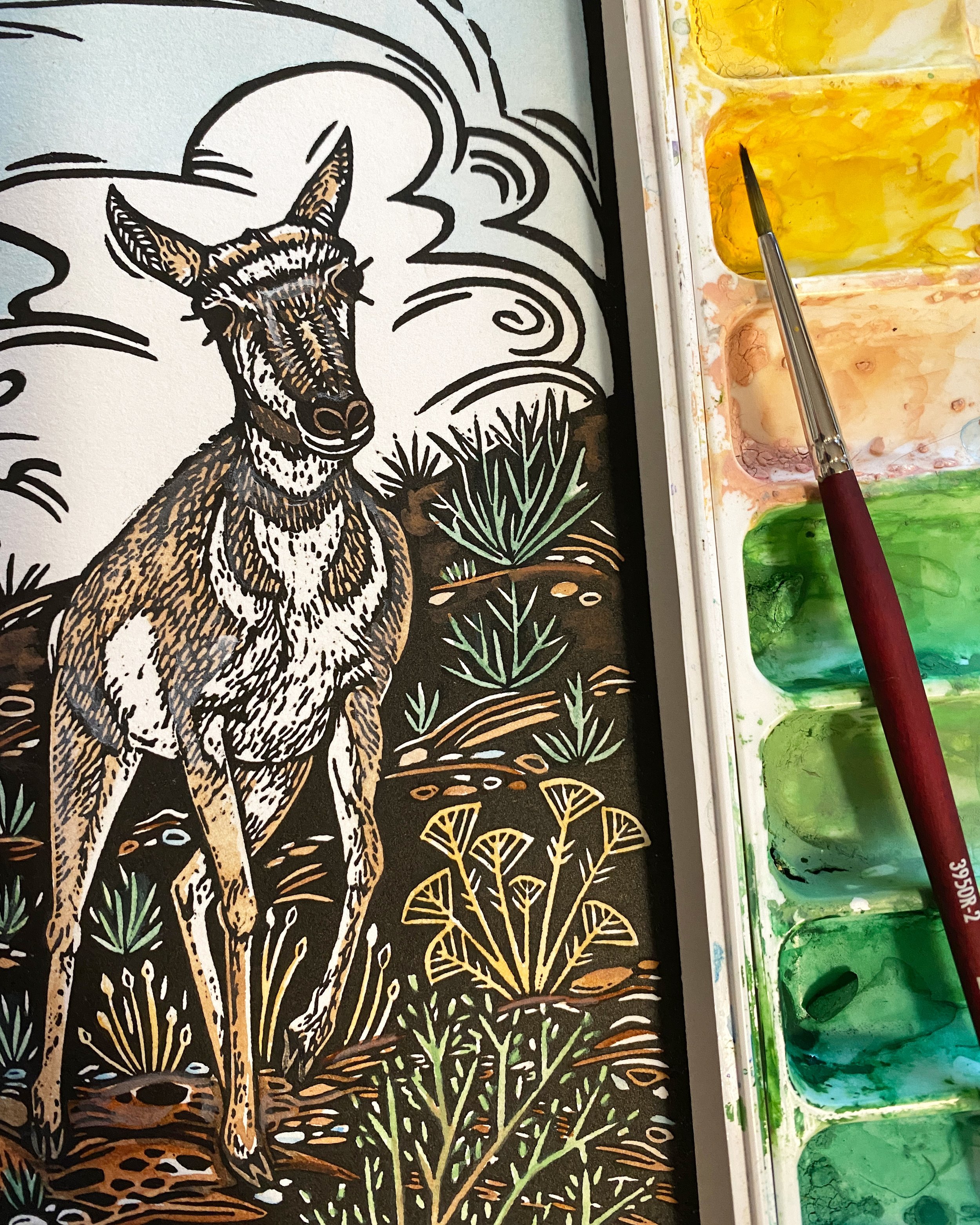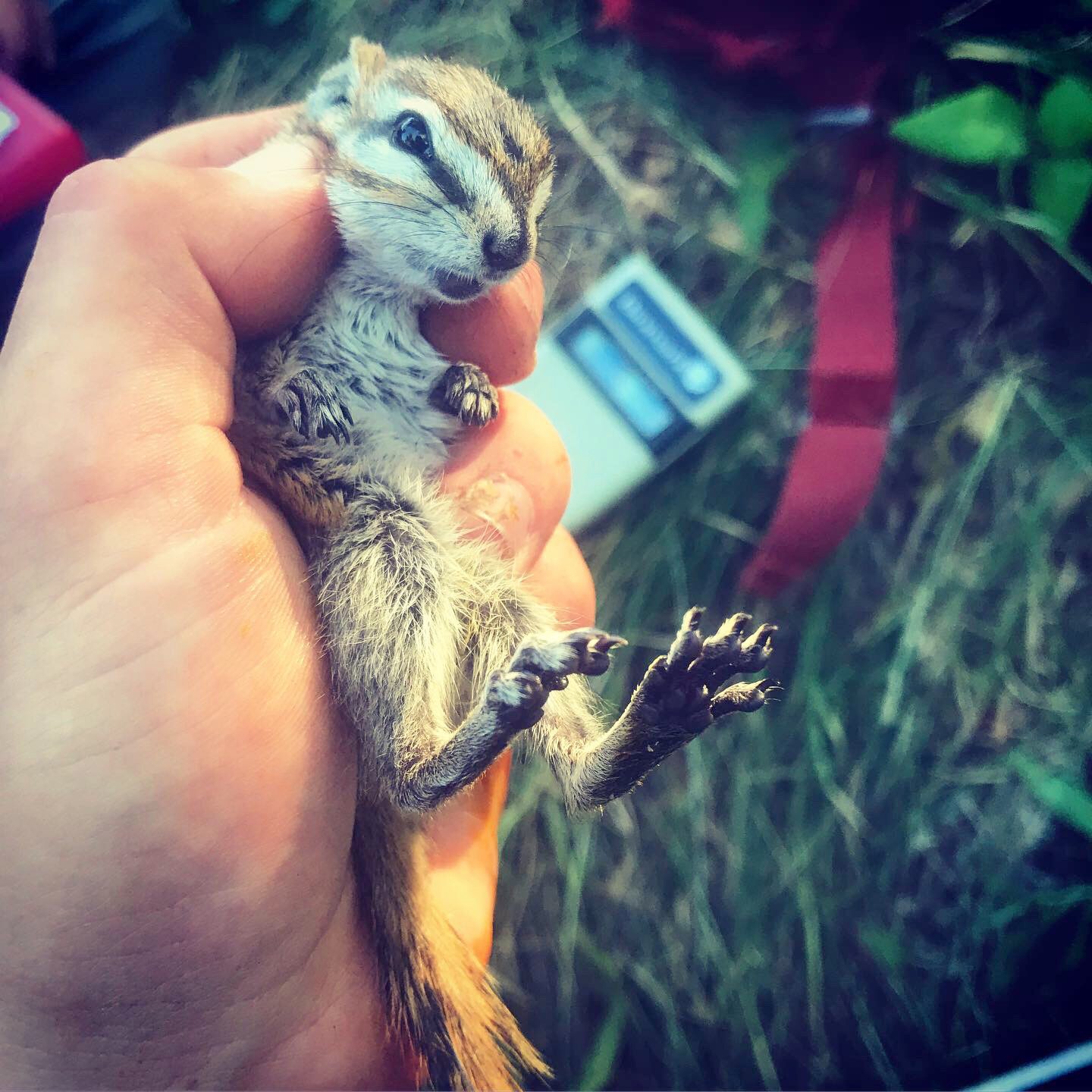Some of the most common wild animals we see zipping around forests or climbing trees in our backyards are still not well understood by scientists. In the western U.S., one of those small mammals is the least chipmunk. With distinctive dark and light stripes down their backs and over their faces, these chipmunks are the smallest in North America.
One scientist dedicated to studying the least chipmunk is Eric Quallen, a doctoral student at the University of Wyoming. Eric can often be found checking traps in the Laramie Range or hiking with a radio receiver searching through frequencies for the small collared chipmunks they are tracking.
Eric working in the field, photo provided by Eric Quallen
Eric’s advisor, Merav Ben-David, started the chipmunk research project in 2006 as a way for college students to learn about field work and collect data. Originally, the plan was to use squirrels, but they weren’t very resilient. Chipmunks were also getting into the traps, and they turned out to handle the trapping process well, so chipmunks became the star of the project.
Least chipmunks eat a wide variety of foods including nuts, berries, fruits, grasses, fungi, insects, and even small birds and mammals. They have cheek pouches to store food while moving it to a cache, or just to carry what they have foraged and eat it somewhere else. When trapping chipmunks, the UW students put an apple in the cage. Eric says:
“Chipmunks get moisture from their food, so the apple helps keep them from getting dehydrated if they are in the trap all day. We also put in a ball that is a mixture of peanut butter, oats and molasses. It’s fragrant and that helps attract them. It’s more food than a chipmunk needs, but if a squirrel gets in there by accident, it will get them through the day.”
Photo provided by Eric Quallen
In the fall, along their trap lines in trees and sage brush areas, Eric and the UW students open their traps early in the morning, and go back to check on them in the late afternoon for 5 days in a row. In the spring, Eric is back to trap and check on the chipmunks again before they reproduce. This helps the group understand the population growth from spring to fall, and also track the deaths that happen over the winter. Over the years, this research project has been a great teaching tool not just for UW students, but also high school students, middle school students, and citizen volunteers. As the students define new research questions, different equipment is used, and new tasks are added to the project.
Least chipmunk wearing a radio collar with antenna- photo provided by Eric Quallen
“In 2015 we wanted to know more about their movements, home ranges, and dispersal, so we started using tiny radio collars. Chipmunk necks are about the width of your ring finger, so we need really small collars. We thread a zip tie through a radio transmitter and then put tubing over it so it doesn’t rub on the chipmunks’ skin. It’s a sealed VHF transmitter, not GPS. Each collar puts out a radio signal with a unique frequency. There is a little antenna that we thread through the zip tie. The transmitters only last for about a month, but that’s enough data for us to determine home ranges. Someone has to go out and find these 20 chipmunks every day, because there is no way for the data to be downloaded. You hike around with a radio receiver listening to every single frequency, and record the GPS points when you find them. It’s quite labor-intensive.”
In addition to the radio collars, Eric and the students scan each animal for a microchip. If there isn’t one, the students insert one between the shoulder blades, just under the skin. These microchips are also called PIT tags, standing for Passive Integrated Transponder. They don’t emit a signal, but a scanner will register and provide an ID for that particular animal.
“If the chipmunk has a PIT tag, we weigh them and let them go. If not, we anesthetize them using a liquid poured onto cotton balls that turns into a gas inside a jar. The chipmunk also goes into the jar, and usually passes out after about 10 seconds. Then we pull the chipmunk right out. For a large animal, you’d need to have this gas metered and use a gas mask, but for the chipmunks that was impossible. So we anesthetize them by eye, which is nerve wracking. We did consult with vets and got approval for this protocol.”
“Next we determine the sex, and then weigh them. We weigh them in a bag with a hanging scale and if we’ve anesthetized them, we try to do this while they are still passed out, otherwise they jump around in the bag and that can be tricky. Then we insert a PIT tag between their shoulder blades under the skin using a hollow point needle. The tag is about 7 mm long, quite small, although proportionally it would be like putting a Twinkie between our shoulder blades.”
Photo provided by Eric Quallen
Eric had something dramatic happen once while anesthetizing a chipmunk. Although there aren’t usually problems, there is always the possibility there could be an adverse reaction:
“I took the chipmunk out of the jar and it was passed out like normal. I inserted the microchip and put the chipmunk in the weigh bag. When it was in the bag, I realized it wasn’t breathing. This has happened very infrequently to our group, but it hadn’t happened to me before. I have my Wilderness First Responder certification and I wanted to try to do something for this chipmunk! But you can’t just blow into a chipmunk’s lungs, you’d explode them. We always have our tool kit with us, like a fishing tackle box. I laid the chipmunk on its back on top of this kit, tilted its head back, and blew air toward it from about 6 inches away. I was blowing into the chipmunk’s mouth, and its stomach was actually rising up and down. Those are still what we’d call ‘dying breaths,’ so I took my finger and massaged its chest lightly. I alternated back and forth between those two things. After a minute or two, I could see the breathing move up from the stomach to the chest. I backed off a little and let it recover itself. It rolled over and slowly sat up, then ran off. At that point, I wondered if it actually recovered fully, or went off to die somewhere. But we caught it every day after that for the next four days. It came back every single time! Maybe it was either stupid or grateful?”
The trapping, collaring, and microchips have taught Eric about the lifespan of least chipmunks, which is actually not well established in current literature. Many chipmunks don’t survive their first winter. They have to dig a burrow called a hibernaculum, and cache food to get through the winter. Chipmunks are born in the spring, and by fall when the students are trapping, even the animals born earlier in the year look the same as the older adults, so that makes guessing their age difficult.
When we age the chipmunks, we underestimate. If we catch them for the first time in the spring, we assume they are a year old. When we catch them in the fall, we assume they are half a year old. Probably they live closer to two or three years. If the animal has a PIT tag, that identifies when we first caught them and we can age them based on that. Fairly regularly we catch three to five-year-olds. It’s rare that we get seven or eight-year-olds. One time we caught a nine-year-old. Chipmunks live longer than you think!
In Wyoming, least chipmunks hibernate from mid-October through April. They aren’t true hibernators, but conserve energy and enter a state of torpor for long stretches. They wake to eat food that they’ve cached, and if the weather is good, they will come out occasionally over the winter. Their burrows are underground, often near something that helps give it structure, like at the base of a tree. There is a main chamber, some food cache chambers, and usually an established latrine area.
Some species of chipmunk are beginning to reduce the time spent in their hibernacula because of climate change. When the winter is warm, it may not trigger chipmunks to hoard food or enter their torpor state as usual. This could expose them to more attacks by predators if they are foraging in the winter. Also because of climate change, they may be reducing their activity in the summer on hot days. Some species that live at higher elevations like the alpine chipmunk in Yosemite National Park have already started shifting their habitat further up the mountain to stay in their preferred temperature range. This creates islands of individuals and reduces genetic diversity overall. It is unknown how climate change will impact least chipmunks, but temperature and weather changes could start to affect any seasonal hibernators.
Photo provided by Eric Quallen
In the spring after the chipmunks come out of their burrows, they mate and the females prepare nests. The nests are lined with grass and leaves and tucked into protected places in brush or rock piles, in stumps or under logs. They typically have four to six babies each year. The young are born hairless, blind, and about one to two inches long. The mother cares for them and nurses them for about two months while they grow.
In addition to studying least chipmunks in the wild, the UW students also have a captive population. They learn a lot about the social structure of chipmunk groups from those in the enclosure. Chipmunks are mostly solitary, but they will work together, learn from each other, and huddle together for warmth when their burrows don’t have enough natural insulation.
Eric is interested in chipmunks’ memory and how they learn. He has created experiments with the captive group using simple mazes. Because chipmunks store food in different places, it’s likely they have good spatial memory to help them remember locations. He also has a 3D printed chipmunk model that could be manipulated to teach real chipmunks a series of steps to get a food reward. Another question Eric is beginning to investigate is whether chipmunks retain memory through hibernation.
“There’s a lot that we have to learn from these ‘backyard species.’ People assume we know so much about them, but we really don’t. The field of animal behavior is still so novel. There is a lot that we take for granted about animals that we don’t actually understand.”
Eric is interested in continuing to study common species over his career. He enjoys helping students and citizen scientists learn about the scientific process and wildlife biology, while increasing understanding of the animals that live around us.
Photo provided by Eric Quallen









